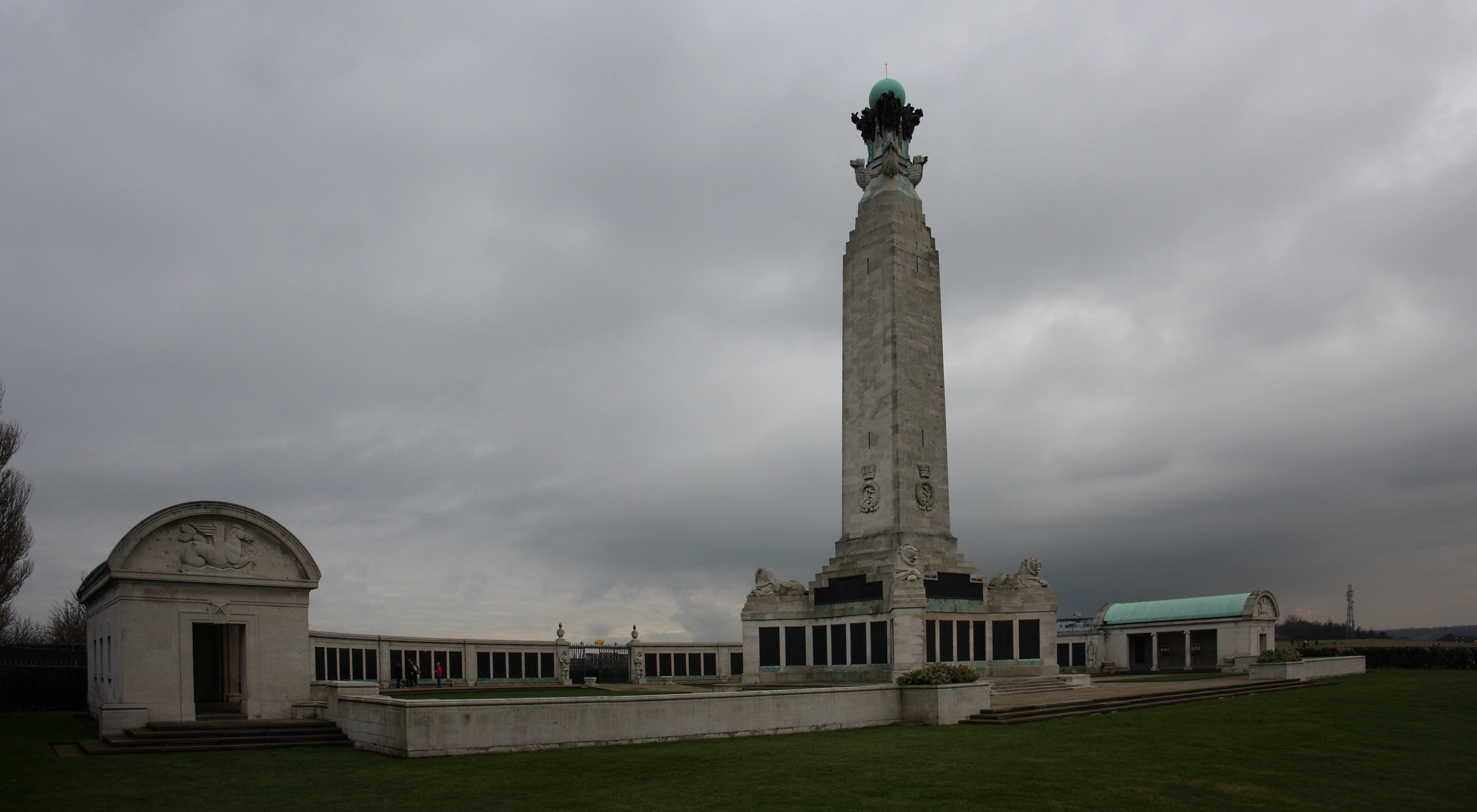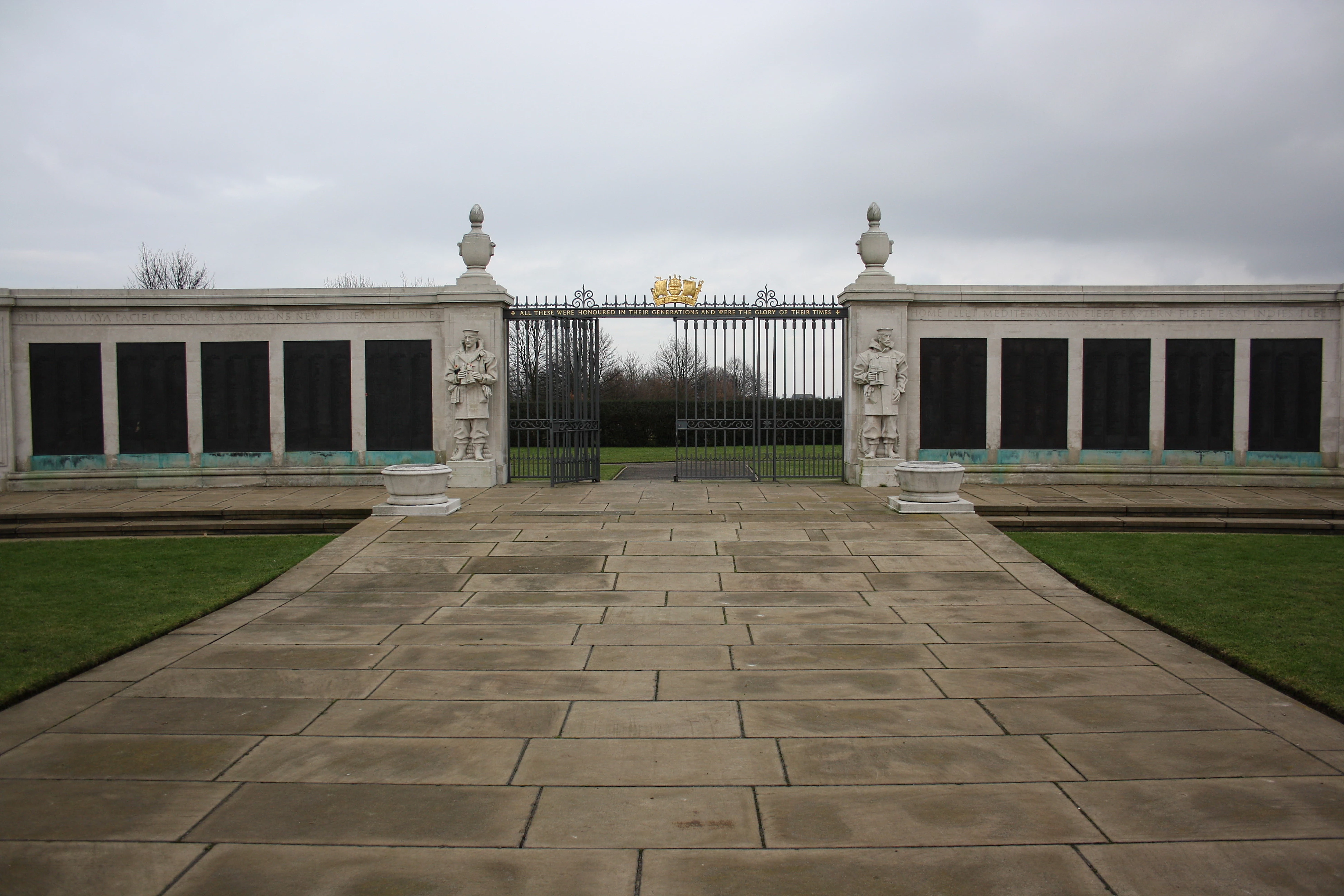Chatham Royal Naval War Memorial, Great Lines
The Chatham Royal Naval War Memorial is situated on the Great Lines, to the North of the town centre, overlooking Chatham and the Dockyard on the Medway. It is dedicated to the memory of those sailors from Chatham-based ships who died during The Great War (1914-18) and World War 2 (1939-45). It is one of three, the others at Portsmouth and Plymouth, that stand both in tribute to the glorious dead, and as navigational guides to modern sailors. The three are themselves part of a network of memorials to the dead across the entire British Empire, from Canada to South Africa, India and Bangladesh.

 The entrance to the memorial has a pair of black wrought iron gates, around
ten feet tall. Above them is inscribed '
All these were honoured in their generations and were the glory of their times' in gold letters. There are three small plaques beside the entrance gates. The plaque on the left says:
The entrance to the memorial has a pair of black wrought iron gates, around
ten feet tall. Above them is inscribed '
All these were honoured in their generations and were the glory of their times' in gold letters. There are three small plaques beside the entrance gates. The plaque on the left says:

The Chatham Naval Memorial
This memorial commemorates officers, ranks and ratings of this Port who died at sea during the wars of 1914 to 1918 and 1939 to 1945. Actions in which they fought are recorded in the registers and on the memorial itself.
Similar memorials at Portsmouth and Plymouth commemorate men and women of those manning ports, while merchant seamen who died from enemy action and have no grave but the sea are commemorated in Liverpool and at Tower Hill in London. The names of those who died during the Second World War whilst serving in the Royal Naval Patrol Service or the Fleet Air Arm and whose graves are unknown are respectively on memorials at Lowestoft and at Lee-on-the-Solent.
Other memorials, at Halifax and Victoria in Canada, at Auckland in New Zealand, at Bombay inIndia, at Chittagong in Bangladesh and at Hong Kong, commemorate sailors who came from those parts of the Commonwealth, while the Newfoundland memorial and Beaumont Hamel in France bears the names of Newfoundland sailors lost at sea during the First World War.
The names of over 18,500 men and women are recorded on this memorial; of these some 8,500 died during the First World War and 10,000 during the Second World War. All were buried or lost at sea or were otherwise denied, by the fortunes of war, a known and honoured grave.
This memorial was built and is maintained by
the Commonwealth War Graves Commission.
1914-1918 Memorial
Architect - Sir Robert Lorimer, Sculptor - Henry Poole.
1939-1945 Extension
Architect - Sir Edward Maufe, Sculptor -Sir Charles Wheeler.
On the right, the top plaque states:

The names on this memorial are arranged according to year of death. Those for the 1914-1918 war appearing on the obelisk (Commencing with panel 1) and those for the 1939-1945 war on the enclosing wall (commencing with panel 33)
Within each year they are arranged according to service (e.g. Royal Navy, Royal Marines), within each service according to rank, and within each rank in alphabetical order according to surname.
The register of names may be seen at the Garrison Church, Maxwell Rd, Brompton
The bottom plaque, which is rather newer than the others, says:
As a result of constant vandalism at the memorial the Commonwealth War Graves Commission has had to arrange for it to be regularly patrolled and public access limited to the period from 08.30 to 17.00
Should for any reason the memorial be closedduring the stated hours please telephone the Guard Room at Brompton Barracks on 01634 822442 who will arrange for the gates to be opened
Any inconvenience to visitors is greatly regretted
Further information about the memorial can be obtained from the Commission at Jenton Road, Sydenham, Leamington Spa
(Tel 01926 330137. E-mail director@cwgcuk.org)
The memorial is unchanged, save regular maintenance, since the outer walls were added after the second world war. So far the Commonwealth War Graves Commission has succeeded in mostly staving off the efforts of vandals, although the restricted access times are a price that must be paid. The idea of vandalizing these memorials is repellent to most, carried out by those whose families would be ashamed of them, or maybe by those whose families themselves were no better and passed it down.

The names of 8,500 of those who died in The Great War are located on plaques on the central memorial, which bears the inscription "In honour of the Navy and to the abiding memory of those ranks and ratings of this port who laid down their lives in the defence of the Empire and have no other grave than the sea".
The memorial was designed by Sir Robert Lorimer, as a counterpart to the similar ones in Portsmouth and Plymouth. It was the first of the three memorials to be completed and was unveiled by the Prince of Wales, later King Edward VIII, on 26th April 1924. It was also intended to act as a guide to shipping.
After the Second World War the memorial was extended by the addition of the outer wall, which forms a semi-circle on the side of the memorial away from the town to give protection against the wind. 10,112 names are commemorated on the fifty plaques on the extension.

The inscription above the inside of the gates in the Second World War Extension Wall matches that on the outside and is taken from Chapter 44 of the Book of Ecclesiasticus:
All these were honoured in their generations and were the glory of their times
The gates are guarded inside by two statues representing sailors on constant watch.


The Second World War Extension was unveiled by The Duke of Edinburgh on 15th October 1952.
The two matching memorials at Portsmouth and Plymouth differ in their designs for memorials to the dead of the Second World War. This is because they are all in different surroundings and, at the time the central obelisk memorials were built, nobody thought another war would happen killing even more people.

If you ever have the chance to visit, be sure to take it. To be surrounded by the names of 19000 men and women who fought and died is a truly humbling experience. Their names forever seen from almost everywhere in Chatham, and where you can see all of the town and beyond; the last part of Britain many of them saw.
Correspondence
As you may have seen on the Forts and Strange Things pages, Dave wrote to me and had the following to say about the war memorial:
Once we were playing at the War Memorial on the Lines, on the centre of the memorial where the metal plaques are, there is one with a keyhole, we found this open one day and had a look inside. Not only does it go up, it goes down too. We were chased off by the men that were inside.
I've never seen a keyhole on any of the plaques, although to be fair I've never seriously looked for one. Looking at the central obelisk though, you can see there are some slotted openings in it, so I assume there's access to the top from the inside. If there are steps headed downwards that isn't necessarily surprising, and the memorial is above Fort Amherst and, I think, HMS Wildfire.
In-Site Links:
External Links:
The Commonwealth War Graves Commission's information about the memorial may be found here.